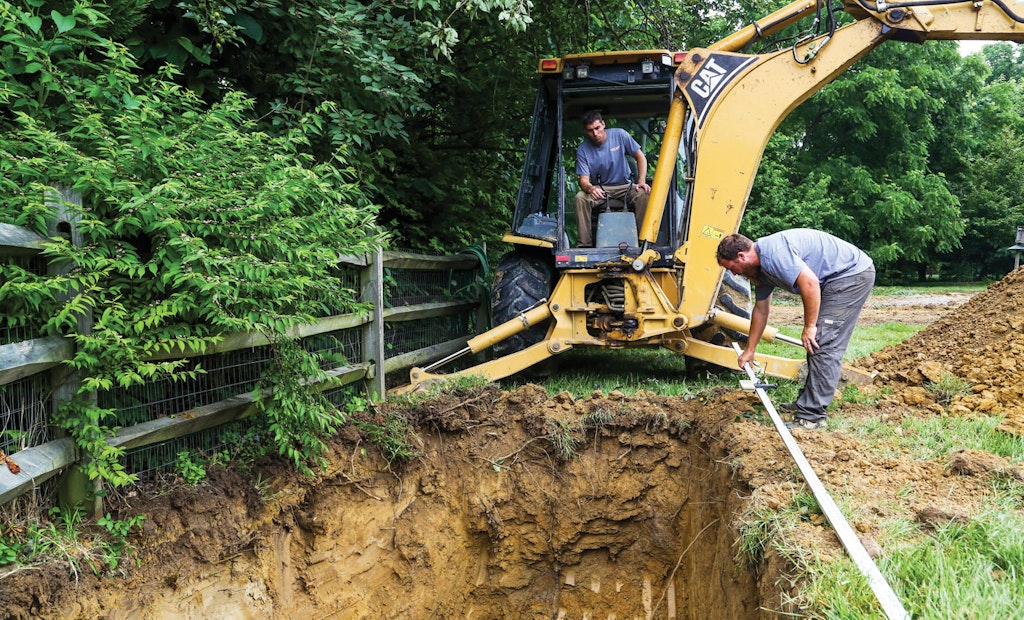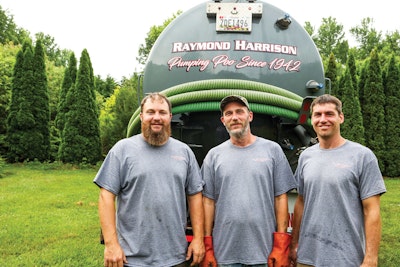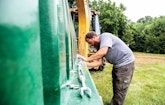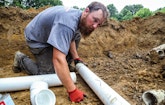
Ray Harrison measures an excavation for a system install while David Stoltzfus waits at the controls of a 2007 416D Cat backhoe.
Raymond Harrison Septic Services has been around for more than 75 years. It’s been a fixture in eastern Maryland for more than 50, and it is still in business because it adapted.
If you live near Chesapeake Bay or follow news coverage about its water quality, you know the issues Harrison Septic faced. Water quality in the bay was in decline. The fishing industry was in trouble, and wildlife was suffering. When water regulations changed in an effort to heal the bay, it meant change for installers who work in the area.
The advantage Harrison Septic had was Harry Harrison, the late father of Ray Harrison, who now owns the company with his wife, Anna Harrison, and David and Jayme Stoltzfus. The elder Harrison saw the new regulations coming, and starting in 2006, he prepared his company for a new future, Ray Harrison says.
Environmental wake-up
Chesapeake Bay was the first estuary targeted by Congress for restoration. That started in the late 1980s after a study fingered excess nutrient loads as the cause of the loss of marine creatures and wildlife. Since then, a partnership among several states, about 1,800 local governments, more than 20 colleges or universities and more than 60 businesses and nonprofit groups has worked to reduce the nutrient load. In 2010, the U.S. Environmental Protection Agency established a total maximum daily load of nutrients and sediment for the bay.
In 2006, Maryland regulations began requiring best available technology for onsite systems within the Chesapeake Bay Critical Area. This is the strip of land within 1,000 feet of tidal waters and tidal wetlands, and it comprises about 11 percent of the state. It was the latest step in the process that Harry Harrison saw coming.
“When the new advanced technology systems came out, a lot of the old-timers were set in their ways and were skeptical of the advances with nitrogen-removal tanks. Dad saw this is what we would be doing in the future, so why not get as much information from each manufacturer as he could? And we’re glad he did that, because advanced systems are pretty much all we install now,” the younger Harrison says.
Only 5 to 10 percent of installations are standard septic systems. The rest use some kind of nitrogen-removal technology.
Harrison Septic installs the occasional commercial application but primarily installs domestic systems. Some of those can still be large. Kent and Cecil counties on the north end of Chesapeake Bay have a lot of old money, and many farms now house riding horses or are preserved for hunting.
In addition to installations, Harrison Septic handles the operation and maintenance for systems in the ground. Because that involves a single technician and minimal equipment, the company’s radius of service is greater than for installing or pumping.
Compact drip job
Pumping and installations are done in the central and northern counties of Maryland’s eastern shore. Service technicians cover the state’s entire eastern shore along the Chesapeake, plus Anne Arundel County, which includes the city of Annapolis and touches the edges of Baltimore and Washington, D.C., on the western shore of the bay.
“I was getting so many calls from Anne Arundel County that I had to go over there. It was definitely worth it to make that trip,” Harrison says.
The most interesting project they did recently was a drip system. It was 800 feet of small drip tubing set in 8- to 10-inch-deep trenches. Much of the work had to be done by hand.
A trencher did the initial digging, but after that it was hand labor. Tubing had to be laid by hand and fill sand had to be raked by hand, Harrison says. “You can’t have any machines driving on that area because of compaction. Pretty much your own footprints are the only thing allowed on that soil.”
The dripline ran back to a SeptiTech system. It was also the smallest drip system the company has done. Most have more than 1,000 feet of tubing. But some opportunities for large systems are disappearing.
Rural subdivisions are transitioning to municipal sewer because there is diminishing space for onsite systems. So the subdivisions are connecting to nearby small towns that operate their own wastewater systems.
The business breaks down like this: 60 percent installations, 25 percent pumping and 15 percent maintenance.
In the garage
Harrison Septic gets a lot done, and the equipment list reflects that.
The company’s vacuum truck is a 2008 International formerly used as a road tractor. When Harrison was looking for a truck, there was a shortage of used rigs on the market. They hired National Truck Center to extend the tractor’s frame, add another dual axle, make a 4,000-gallon steel tank, put on the Jurop/Chandler pump and paint it.
In addition the company has a:
- 2007 International single-axle dump truck
- 2007 416D Cat backhoe
- 2015 277D Cat tracked skid-steer
- 1999 Ford F-350 dually service truck
- 2005 Freightliner 10-wheel rollback that hauls the backhoe or skid-steer
- 2009 GMC Canyon service truck.
They have a jetter, but not a purpose-built machine. Instead they use a hose and heads from MyTana Mfg. connected to a Stihl pressure washer.
Their camera is a General Pipe Cleaners/General Wire Spring Gen-Eye SD.
Bring back pumping
Harrison Septic Services had its origin with Ray Harrison’s grandfather (also Raymond Harrison) in Greenville, South Carolina. It was a large company running six pump trucks. In the 1950s, he moved north to Maryland and set about building a new septic business in an area where the company name was unknown.
Harrison Septic has always been an installation company, but the pumping division has come and gone. It was sold around 2000 but repurchased a couple of years later. In 2007 the pumping division was sold to Service Energy in Delaware, which kept the company name and pumped locally. When Harry Harrison died in 2016, both men were working for Service Energy to do pumping. In addition, Ray Harrison was working for Harrison Septic Solutions that he and Anna Harrison founded in 2012. Just after his father died, Service Energy approached Ray Harrison and asked if he would like to buy the company name back.
“That was very decent of them,” Harrison says. The pumping business had dropped from three vacuum trucks to one, but Harrison has plans to change that. When the pumping company came back to the family in 2017, it was under a new name — Raymond Harrison Septic Services, which unified both the pumping and installation businesses. A new partner, David Stoltzfus, joined the team. It was good timing for both of them, Harrison says.
Stoltzfus was just getting out of his family business and was looking for other opportunities. He had worked in construction and acted as a general contractor building houses, so he was familiar with excavation and onsite systems. At the same time, Harrison was picking up more work and needed help if the company was to remain manageable. And they’re both the same age: 34.
They divide work by skills. Harrison does most of the operations and maintenance work. Stoltzfus handles the vacuum truck scheduling, and together they do the installations. Pumping is handled by a full-time driver.
“We’re still in the rebuilding stage, and we’ll need more help soon,” Harrison says.
A big plus is the company name, which never disappeared from the area since his grandfather established the company. Service Energy had continued to use it. “If it wasn’t for the name that’s been here forever and the fact that a lot of people know me and knew my father, it would have been a lot harder,” Harrison says.
Making connections
Growing the business means making sure its presence is consistent and reaches people where they are. For the Harrison team, that means electronic referrals plus word-of-mouth.
A new website is in the works because the current one says Harrison’s Septic Solutions, and while one of the Facebook pages is labeled the same way, the goal is to unify operations under a single name: Raymond Harrison Septic Services. The Facebook pages need updating, too.
“Facebook has been a huge benefit to us,” Anna Harrison says.
Every month a couple of people message the company through Facebook and ask for a pumpout. For Labor Day weekend, they ran a Facebook ad (that reached about 4,000 people in their area) telling people the company is available for emergency calls if an onsite system backs up from overuse at a holiday picnic. That single $10 ad brought in a pumping job, which more than covered the cost, she says.
There are also Facebook pages for various area communities where residents ask for referrals for pumping companies. Friends can like for the Harrison Septic page.
Aside from the online efforts, the company truck is an effective marketing tool.
“It’s so big that it’s like a rolling billboard going down the road. If it’s parked for an hour for lunch at McDonald’s, whoever drives by, it jogs their memory that they need their tank pumped,” Ray Harrison says. If they pump one tank in one neighborhood, it’s likely they’ll have three or four calls from the same neighborhood in the next week. Occasionally people won’t wait to call but will approach the driver on the spot and ask for service.
The company also has good relationships with area real estate agents, and they’re usually the first people on site when a house is to be sold and there are questions about its onsite system.
On the grow
Within a year Harrison would like to have two pump trucks running. Even if it’s not used full time, a second truck would provide backup for the primary truck and would enable the company to add some extra services, such as jetting.
He would like to assemble a crew who could work independently on an installation site, while he and Stoltzfus attend to other tasks. In addition to Harrison, one service technician is on duty once a month and another is about to come on part time. Harrison expects that part-timer to be full time within a few months.
Harrison is always trying to craft forward-thinking strategies like his father before him. With hard work, perseverance and future generations willing to stick with the wastewater industry, folks around Chesapeake Bay may see trucks emblazoned with the Harrison Septic name for many years to come.
Always on call
There are ways to boost any business. Management gurus talk about them — controlling costs, marketing, finding a niche. But gurus seldom seem to address the one universally necessary quality: hard work. It’s what Ray Harrison has going for him as he seeks to rebuild his family company. And hard work doesn’t necessarily mean 16-hour days. It can mean simply being available when the job needs to be done.
In his rural area — and he grew up there so he knows — many people are difficult to reach after 4:30 p.m. When hunting season comes, some people disappear for weeks. “All of that has been good for us because I was brought up to work hard no matter what time of year it is,” Harrison says.
There are jobs he won’t do — also part of good service. In early spring and summer, when house sales are at their peak, Harrison refers inspections to a specialist company. It may look odd for his company to do an inspection and then undertake repairs at the same property, he says.
Harrison also makes sure it’s easy to reach someone at his company. A dispatcher answers calls between 7 a.m. and 5 p.m. Monday through Friday. After 5 p.m. and on weekends, many calls are routed to the home of his partner David Stoltzfus. But because he is a certified technician for several advanced treatment unit manufacturers and his number is available through them, those calls for service go directly to his cellphone.











